In a tumultuous week for global markets, the ongoing trade war between the United States and China has sent shockwaves through stock exchanges worldwide. On April 8, 2025, the Taiwan Stock Exchange opened in the red, with the Taiex index plunging nearly 3% shortly after the opening bell. This followed a historic loss of 9.7% on the previous Monday, marking the largest daily drop in the exchange's history.
Meanwhile, the Indonesian stock market faced a severe downturn, crashing by over 9% within minutes of opening, which led to a temporary suspension of trading due to new regulations aimed at managing extreme volatility. The Indonesian bourse had been closed for public holidays and had not operated during the previous week, compounding the negative sentiment as global markets reacted to the latest U.S. tariffs.
Other Southeast Asian markets also felt the heat, with Vietnam's index down by 5.04%, Thailand dropping 4.08%, and Singapore losing 1.63%. However, the Philippines and Malaysia managed to open with slight gains, up by 2.04% and 0.30%, respectively. This mixed response illustrates the varied impacts of the trade tensions across different economies.
On Wall Street, the situation was no less grim. The Dow Jones Industrial Average closed down 0.84% at 37,645.84 points, while the Nasdaq fell 2.15% to 15,267.91 points, and the S&P 500 dropped 1.57% to 4,982.78 points. This marked the first time in a year that the S&P 500 closed below the 5,000-point threshold, reflecting investor anxiety over the potential for a global recession fueled by the escalating trade conflict.
In response to the U.S. tariffs, which are set to be implemented at a staggering 104% on certain Chinese goods, Canada announced it would impose a 25% tariff on American cars starting April 9, 2025. This move underscores the ripple effects of U.S. trade policies, which are prompting retaliatory measures from affected countries.
Despite the turmoil, European markets showed signs of recovery. On April 8, European exchanges rebounded, with gains of over 3% across major indices as investors reacted positively to the opening of Wall Street. Milan's stock exchange, for instance, finished with a notable increase of 2.44%, bringing the Ftse Mib index back to 33,657 points. Other notable gains included Paris at 3.36%, Frankfurt at 2.9%, and London at 3.48%.
The EU has also prepared a phased response to the U.S. tariffs, with counter-tariffs set to be implemented in three stages: April 15, May 16, and December 1, 2025. A spokesperson for the European Commission emphasized that while they are prepared to use significant measures to counteract U.S. actions, they prefer to resolve the situation through dialogue.
In a recent statement, Donald Trump claimed, "China wants a deal on tariffs but doesn’t know how to start it. I’m waiting for their call." This comment comes amid ongoing tensions, as Trump has threatened to impose additional tariffs of 50% if China does not retract its retaliatory measures. Chinese officials have responded firmly, stating, "We will fight to the end," rejecting any notion of capitulation to U.S. demands.
Amid this backdrop of uncertainty, the Borsa di Tokyo attempted a recovery, rising by 6.03% after a series of heavy declines. Investors were hopeful for negotiations that could mitigate the impact of U.S. tariffs. The Nikkei index saw a significant gain, closing at 33,012.58 points, which was a welcome relief after previous losses.
As the markets react to these developments, the situation remains fluid. The volatility across global exchanges reflects deep-seated concerns about the economic implications of the trade war. Corporate leaders, including Larry Fink of BlackRock, have voiced apprehensions about the potential for a recession, with many CEOs expressing doubts about the sustainability of current economic growth under the strain of trade tensions.
In summary, the interconnectedness of global markets means that the ramifications of U.S. trade policies will continue to unfold, affecting economies worldwide. As countries like Canada and members of the EU prepare their responses, the potential for further escalation looms large, with investors left to navigate this uncertain landscape.





